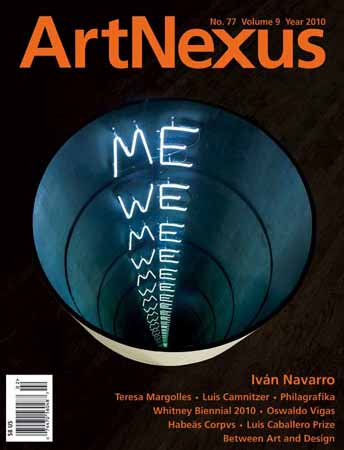Edward Rubin
Summer 2010
From: Rubin, Edward. “Tania Bruguera,” Art Nexus, Issue 77, Jan. – August. 2010 (illust.) pp. 110 – 111.
http://www.artnexus.com/Notice_View.aspx?DocumentID=21641
___________________. “Neuberger Museum Features Installation Art by Cuban Artist; Tania Bruguera: On the Political Imaginary”. D’Art International Magazine. Fall/Winter Issue. (illust.) pp. 1 – 3.
___________________. “Neuberger Museum Features Installation Art by Cuban Artist; Tania Bruguera: On the Political Imaginary”. March 29. ARTES eMagazine, United States.
http://www.artesmagazine.com/2010/03/neuberger-museum-features-installation-art-by-cuban-artist/
___________________. “Neuberger Museum Features Installation Art by Cuban Artist; Tania Bruguera: On the Political Imaginary”. June 2010. Terminal Magazine. Tel Aviv, Israel.
Art Nexus
Download PDF. (ARTNEXUS)
Reviews. Tania Bruguera. Art Nexus
Edward Rubin
Performance Artists have been enjoying a major resurgence in popularity around the world. Spearheading this renaissance art museums and biennales. And why not! Such one-of-a-kind theatrical events where anything can happen and usually does, is primo entertainment. Here in New York City and environs, five major art museums recently played host to a tsunami of performance artists. The Kiss and THis Progress, tow of Tino Sehgal’s live “constructed situations” with a nary a painting is sight, occupied the master, in this case INdia, under the blood-sucking rule of the British Empire.
The most exciting part of the exhibition was the various gallery rooms that housed the artist’s installations. In “Untitled (Havana 2000)” and “Untitled (Kassel, 2002)” — many of Bruguera’s works are named after the city where they were first performed — blackness accentuates the artist’s message. IN “Havana,” we found ourselves in a darkened room walking on a dangerously uneven layer of rotting sugarcane husks. At the far end of the room, on a small, scarcely discernable TV screen, Castro is seen delivering one of his interminably long speeches. Hugging the walls of the room, four naked men, barely visible to the eye, stood imitating the empty gestures of their iconic leader. In “Kassel,” again we found ourselves in a dark room. Only this time, one moment, we were immersed in total darkness, the next ,blinded by blazing overhead lights. Punctuating both darkness and light was the sound of threatening footsteps and a gun being loaded and reloaded, interrogation tactics that could not help but command our full attention.
In “Untitled (Moscow, 2007)” and “Tatlin’s Whisper #6 (Havana Version)” Bruguera, changing her tactics, invited the viewer to be actors in her scenarios rather than passive participants. In “Moscow,” we were ushered into what appears to be a small photo lab, and asked to sit beneath a framed photograph of the founder of the Bolshevik secret police to have our picture taken. Sitters were given the choice of posing with a live eagle representing the power of the old establishment or a cage full of monkeys signifying the rise of capitalism in Russia. In “Tatlin’s Whisper #6,” first performed in Cuba in 2009, citizens were escorted to the stage b individuals dressed in military fatigues and given a minute to talk about anything they wanted to say. Freedom of speech, blogs and the Internet, all censorship related, were the hot topics. Not surprisingly–how could it be otherwise in a democratic society long used to unbridled freedom — less than and handful, and this after much prompting, took to the stage at the Neuberger during the exhibition’s opening, while in Cuba the Havana Biennale authorities shut down Bruguera’s presentation after one performance. If anything was amiss in this exhibition, it is that many of the works removed from their original context were shorn of their ultimate power. Still, we did get more than a whiff of what life is like in countries where freedom of anything is not guaranteed.
Download PDF. Dar’t International Magazine
Download PDF. ARTES eMAGAZINE
Download PDF. Terminal Magazine
